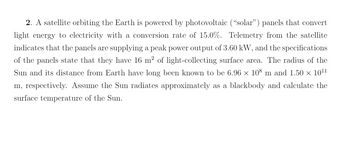Question

Transcribed Image Text:2. A satellite orbiting the Earth is powered by photovoltaic ("solar") panels that convert
light energy to electricity with a conversion rate of 15.0%. Telemetry from the satellite
indicates that the panels are supplying a peak power output of 3.60 kW, and the specifications
of the panels state that they have 16 m² of light-collecting surface area. The radius of the
Sun and its distance from Earth have long been known to be 6.96 × 108 m and 1.50 × 10¹¹
m, respectively. Assume the Sun radiates approximately as a blackbody and calculate the
surface temperature of the Sun.
Expert Solution
This question has been solved!
Explore an expertly crafted, step-by-step solution for a thorough understanding of key concepts.
This is a popular solution
Trending nowThis is a popular solution!
Step by stepSolved in 2 steps

Knowledge Booster
Similar questions
- 14arrow_forward1. According to the electromagnetic spectrum, ultraviolet rays range in wavelength from about 1.00 nm to 400.0 nm. Find the range of energies and the range of frequencies of ultraviolet rays.arrow_forwardCalculate the x- and y-components of the initial velocity using the velocity component equations: V₂ = V0 cos Vy = vo sinarrow_forward
- 5. Review. A snowmobile is originally at the point with posi- tion vector 29.0 m at 95.0 counterelockwise from the x axis, moving with velocity 4,50 m/s at 40.0". It moves with constant acceleration 1,90 m/s at,200", After 5.00 s have clapsed, find (a) its velocity and (b) its posiion vector.arrow_forward5. The reading of micrometer in (mm) is a. 4.62 ± 0.005 0.0005 c. 2.38 0.0005 b. 4.62 d. 2.88 0.005 qu 45 40 35 30arrow_forward3) How bright will Pluto appear in reflected or scattered sun-light (total Flux received in W/m²) at the Earth when Pluto is at Opposition and a distance from the Sun of 40.0 A.U.? Assume that Pluto has an albedo of 0.60 and a radius of 1.2 x 10³ km.arrow_forward
- Find the energy (in eV) of a photon with a frequency of 6.7 ✕ 1016 Hz.arrow_forward06) A spacecraft antenna is at an angle of 10° relative to the axis of the spacecraft. If the spacecraft moves away from the earth at a speed of 0.70c, what is the angle of the antenna as seen from the earth?arrow_forward1. Read and U What information are you given? Mass= m = 0.15 kg Speed of light = c = 300,000,000 m/s = 3 x 108 m/s 2. Plan and Solve What unknown are you trying to calculate? The amount of energy produced = E = ? What formula contains the given quantities and the unknown? E = mc2 Replace each variable with its known variable and known value. E = (0.15 kg)(3.00 x 108 m/s)2 E = 1.35 x 10¹6 kg.m²/s2 = 1.4 x 1016 J 3. Look Back and Check a separate In a nuclear reactor, 1.5 kilograms of plutonium-239 is completely converted to energy. How many joules of energy are produced? nitsarrow_forward
- The wavelength of visible light is from, O 400 m to 700 m O 400 km to 700 km O 400 cm to 700 cm O 400 nm to 700 nmarrow_forwardWhat is the energy of light having a frequency of (8.61x10^14)? Answer to 3 significant figures in scientific notation. Unit is case sensitive. Note: Your answer is assumed to be reduced to the highest power possible. Your Answer: Answer X10 unitsarrow_forwardA. 10x 10" B. 1.4x10" C. 2.7×10J D. 6.8x10"J 8. How much kinetic energy does an electron (m = 9.1x10 kg) have if it is traveling at one-half the speed of light?arrow_forward
arrow_back_ios
SEE MORE QUESTIONS
arrow_forward_ios